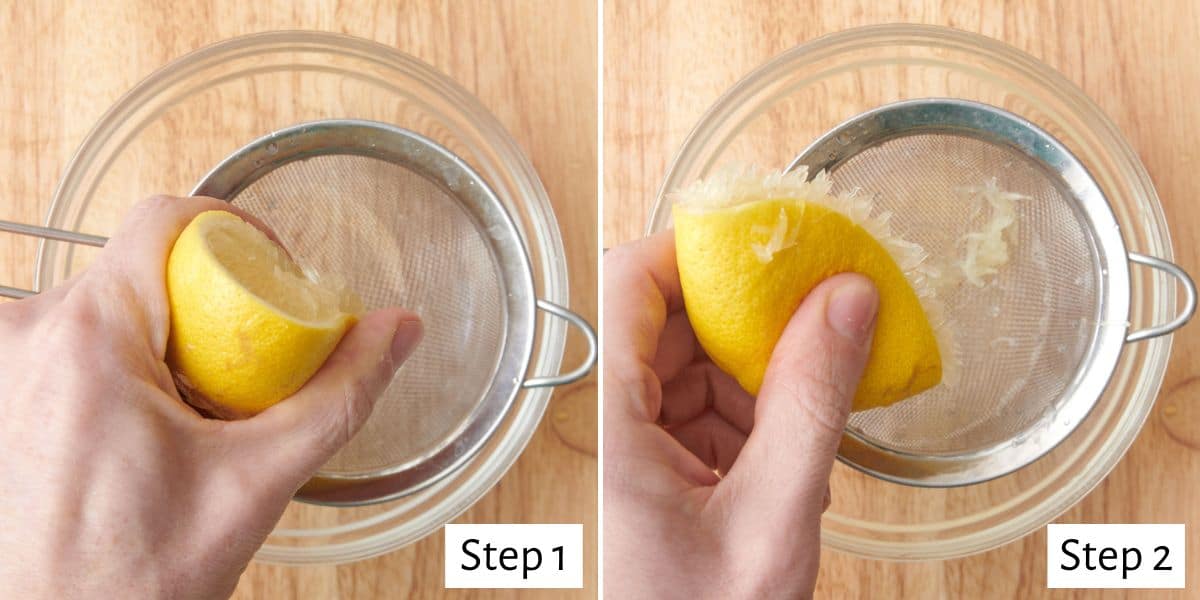This post may contain affiliate links. Please read our disclosure policy.
Need fresh lemon juice for a recipe or to make lemonade? Follow my easy tutorial on how to juice a lemon six different ways! I’ll show you how to get as much lemon juice as possible from your lemons, from hand-squeezing to using a fork or even a blender!

Jump to Section
- Ingredients to Juice a Lemon
- How to Get The Most Juice Out of a Lemon
- How to Juice a Lemon by Hand
- How to Juice a Lemon with Citrus Reamer
- How to Juice a Lemon With a Citrus Juicer
- How to Juice a Lemon With a Fork
- How to Juice a Lemon With a Blender
- How to Juice a Lemon With a Microwave
- Tips for Juicing Lemons
- Recipes to Make with Lemon Juice
- How to Store Lemon Juice
- Frequently Asked Questions
- More Cooking Tutorials:
- How to Juice a Lemon Recipe
Each juicing method has its own pros and cons, whether you’re working with basic kitchen tools or specialized gadgets. I’ll go through simple techniques like using a citrus reamer or citrus juicer and slightly unconventional methods like using your microwave to get the most juice out! Plus, I’ll share handy tips on picking the right lemons for maximum juice yield and how to store any leftovers to keep them fresh.
Ingredients to Juice a Lemon

- Lemon: These citrus fruits are known for their bright yellow color, tart flavor, and high acidity. Lemons are rich in vitamin C and are commonly used in cooking, baking, and beverages. For the maximum amount of lemon juice, use lemons that are fresh, ripe, and heavy for their size.
How to Get The Most Juice Out of a Lemon
- Roll the lemon on a countertop with the palm of your hand to loosen the juices.
- For all methods except blender and microwave, cut the lemon in half.

How to Juice a Lemon by Hand
- Hold one lemon half over a bowl with a sieve if desired, cut side down.
- Squeeze the lemon with one hand over a bowl. Repeat with the other half.

How to Juice a Lemon with Citrus Reamer
- Hold one lemon half over a bowl with a sieve if desired, cut side up.
- Use a citrus reamer to twist and press into the lemon, extracting the juice. Repeat with the other half.

How to Juice a Lemon With a Citrus Juicer
- Hold the lemon half over the citrus juicer, cut side down.
- Press down on the juicer to extract the juice and twist if necessary. Repeat with the other half.

How to Juice a Lemon With a Fork
- Hold one lemon half over a bowl, cut side up. Press a spoon or fork into the center of the lemon half and squeeze and twist.
- Using the fork, scrape against the lemon’s sides to extract as much juice as possible. Repeat with the other half.

How to Juice a Lemon With a Blender
- Cut the lemon into small pieces and remove the seeds. Place the lemon pieces in a blender. Add a small amount of water if desired and blend until smooth.
- Strain the mixture through a fine mesh sieve or cheesecloth into a bowl.

How to Juice a Lemon With a Microwave
- Pierce the lemon in several places with a fork or knife.
- Place it into a microwave-safe bowl and microwave for 15-20 seconds.
- Cut the lemon in half.
- Squeeze the lemon juice into a bowl with a sieve if desired.

Tips for Juicing Lemons
- Start with ripe lemons. Look for lemons that are plump, firm, and heavy for their size. Ripe lemons yield more juice and are easier to extract juice compared to underripe ones.
- Roll firmly. Don’t be shy when rolling the lemon across the countertop. You want to break down the membranes and loosen the juices. You can not roll it too much or too hard.
- Apply even pressure. If using a citrus reamer, juicer, fork, or hand, apply even pressure when extracting the juice. Rotate the lemon half to make sure you cover all sections of the lemon.
- Know the yield. The amount of lemon juice you’ll get will depend on the size, ripeness, and juicing method used. However, on average, one medium-sized lemon will yield approximately 2-4 tablespoons of lemon juice. The blender method will yield the most juice.
Recipes to Make with Lemon Juice
- Lemon Honey Salmon
- Vegan Lemon Bars
- Lemon Pasta
- Ricotta Lemon Cake
- Garlic Lemon Chicken
- Minty Lemonade
- Blueberry Lemon Bread
- Lemon Pepper Salmon
How to Store Lemon Juice
Store lemon juice in an airtight container like a small mason jar in the refrigerator. Make sure the jar has a tight-sealing lid to prevent oxidation and keep the juice fresh.
How Long Will Lemon Juice Last in the Fridge?
Fresh lemon juice will last up to 2 weeks in the refrigerator.
Can I Freeze Lemon Juice?
Yes! If you have excess lemon juice that you won’t use within 2 weeks, freeze it! Pour lemon juice into a freezer-safe container, leaving plenty of headspace to allow for expansion. Freeze for up to 6 months. You can also pour the juice into ice cube trays and freeze until solid. Once frozen, transfer the lemon juice cubes to a freezer-safe bag or container. Thaw overnight in the fridge.
Frequently Asked Questions
Rolling the lemon helps you get the most juice out of your lemons. It helps to break up some of the cells and loosen the membranes. This simple trick can sometimes double the amount of juice so don’t skip it!
No! If you want to use lemon zest for a recipe, you should do that before juicing. But if you just need the juice, there’s no need to peel it.
Any fresh and seasonal lemons will work, but Meyer lemons have the most juice and are sweeter than other lemons. Lemons with smoother skin are usually easier to juice compared to those with thick, bumpy skin. Eureka and Lisbon lemons both have thick skin and a very tart and acidic taste so it’s best to avoid those.

Knowing how to juice a lemon using whatever kitchen utensil you have on hand allows you to incorporate them easily into any dish.
More Cooking Tutorials:
- How to Cut Limes & Lemons
- How to Make Lemony Pepper Seasoning
- How to Make Lemon Garlic Aioli
- How to Make Lemony Salad Dressings – 2 Ways
- How to Make Fruity Popsicles
- How to Zest Citrus Fruits
- How to Make Lemony Italian Steak Marinade
If you found this tutorial for How to Juice a Lemon helpful or if you try any recipe on Feel Good Foodie, then don’t forget to rate the recipe and leave a comment below! It helps others who are thinking of trying out this tutorial and we would love to hear about your experience. And if you snapped some shots, share it on Instagram so we can repost on Stories!

How to Juice a Lemon
Ingredients
- 1 lemon
Instructions
Hand squeezing
- Roll the lemon on a countertop with the palm of your hand to loosen the juices.
- Cut the lemon in half. Hold one lemon half over a bowl with a sieve if desired, cut side down.
- Squeeze the lemon with one hand over a bowl. Repeat with the other half.
Citrus Reamer
- Cut the lemon in half. Hold one lemon half over a bowl with a sieve if desired, cut side up.
- Use a citrus reamer to twist and press into the lemon, extracting the juice. Repeat with the other half.
Citrus Juicer
- Cut the lemon in half. Place a citrus juicer over a bowl or glass.
- Put one lemon half on the juicer, cut side down. Press down on the juicer to extract the juice. Repeat with the other half.
Fork or Spoon Method
- Cut the lemon in half. Hold one lemon half over a bowl with a sieve if desired, cut side up.
- Press either a spoon or fork into the center of the lemon half segment and squeeze and twist. Use the fork/spoon to scrape against the lemon’s sides to extract as much juice as possible. Repeat with the other half.
Blender Method
- Cut the lemon into small pieces and remove the seeds.
- Place the lemon pieces in a blender. Add a small amount of water if desired and blend until smooth.
- Strain the mixture through a fine mesh sieve or cheesecloth into a bowl.
Microwave Method
- Roll the lemon on a countertop with the palm of your hand to loosen the juices.
- Pierce the lemon in several places with a fork or knife.
- Microwave the lemon for about 15-20 seconds.
- Cut the lemon in half and squeeze the juice into a bowl with a sieve if desired.
Notes
Nutrition
Nutrition information provided is an estimate. It will vary based on cooking method and specific ingredients used.





